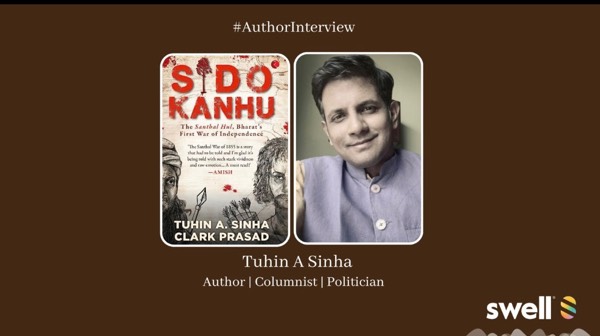
@RupaPublication
This is the official Swellcast of Rupa Publications. For more info, please visit: rupapublications.co.in

Karan Dev
@Karan.Dev · 1:06
Exploring Sido Kanhu and the Indian Subaltern
His book Siddu Kanu is a dramatized recreation of the bravery of a Santal Murmu family. The four brothers Siddu Kanu, Chand and Bhairab and their two sisters Fulu and Janu, the architects of the Santal rebellion are India's largest sub altern uprising against the British, both in terms of geography and impact. Tuan, it's a pleasure to host you on Swell today and I really look forward to hearing your thoughts on the questions which follow

Karan Dev
@Karan.Dev · 0:33
Hello. My first question is with regard to this particular chapter of history, which is rather underexplored and often misunderstood. The Sandal rebellion of 1855 and the story of Siddhu Kanu are parts of history which we know very little about when it comes to mainstream narratives. So what were the primary, according to you, what were the primary socioeconomic and political factors that led to the outbreak of the Santal rebellion of 1855?

tuhin sinha
@tuhins · 4:59
It is said that many of the sepoys used to crush the 1855 rebellion subsequently died in the 1857 revolt. So for many decades, we were not even privy to the minor details of the revolt. But I'm glad India is waking up to realizing and celebrating our unspoken heroes. And Siddharth Kanu, the book is Suraj, my co author, who is better known with his pseudonym Clark. It is Clarkson. My attempt to honor some of these unspoken heroes

tuhin sinha
@tuhins · 2:37
When you talk of socioeconomic factors responsible for the revolt, well, you need to realize that in our subalted areas, in our tribal areas, the Britishers carried out the administration in a very different way vis a vis. They carried it out in places like Kolkata or in urban centers like Delhi. So they would outsource their atrocities. The atrocities of the Britishers would essentially be carried out either through the Zamindars, the landowners, or through missionaries from 1850 onwards

Karan Dev
@Karan.Dev · 0:18
My second question is with regard to the book's introduction. Tuhan talks about how revolts in pre independence Indian history have been appropriated first by British historians and then by post partition Indian national historians. So could you perhaps elaborate on this?

tuhin sinha
@tuhins · 2:44
In fact, as I have mentioned before, our subaltern movements, our subaltern war for freedom started more than 100 years before the formation of the Congress Party. So we need to respect each and every individual who has contributed to India's freedom. And when I talk of each and every individual, obviously the tribal freedom fighters have invariably been left behind, which is why this course correction is being attempted in this era and we are playing a small part in that course correction

Karan Dev
@Karan.Dev · 0:16
How does the Santal Rebellion of 1855 influence and connect with other anticolonial movements in India at the time? Especially such as the broader Indian Rebellion of 1857?

tuhin sinha
@tuhins · 2:53
As a surprise, much to the astonishment of the government, its officers realized that the Santals were right. There was no effective means of dispensing justice, and the economy did not consist of administering taxes without offering anything substantial in return. Based on these findings, the Santal Perganas act of 1855 was introduced. The act consolidated the Santal regions into a separate nonregulation district, the Santal Parganas

Karan Dev
@Karan.Dev · 0:24
And tune for my final question. I'd love to know the influence that the Santal Revolution had. How is the legacy of the Santal Revolution continue to influence tribal riots and movements in modern India? And what are the lessons that can be drawn from this particular historical uprising?

tuhin sinha
@tuhins · 3:19
So ten years ago, if there were certain disputes, they mostly resulted due to a feeling of insufficiency. That insufficiency has been taken care of. And I can say this with responsibility because I have data to support this. The maximum beneficiaries of most of these central government schemes have been the poorest tribals. They have been brought into the mainstream in a far bigger way than was done previously. So I don't really see any of the disputes going ahead
